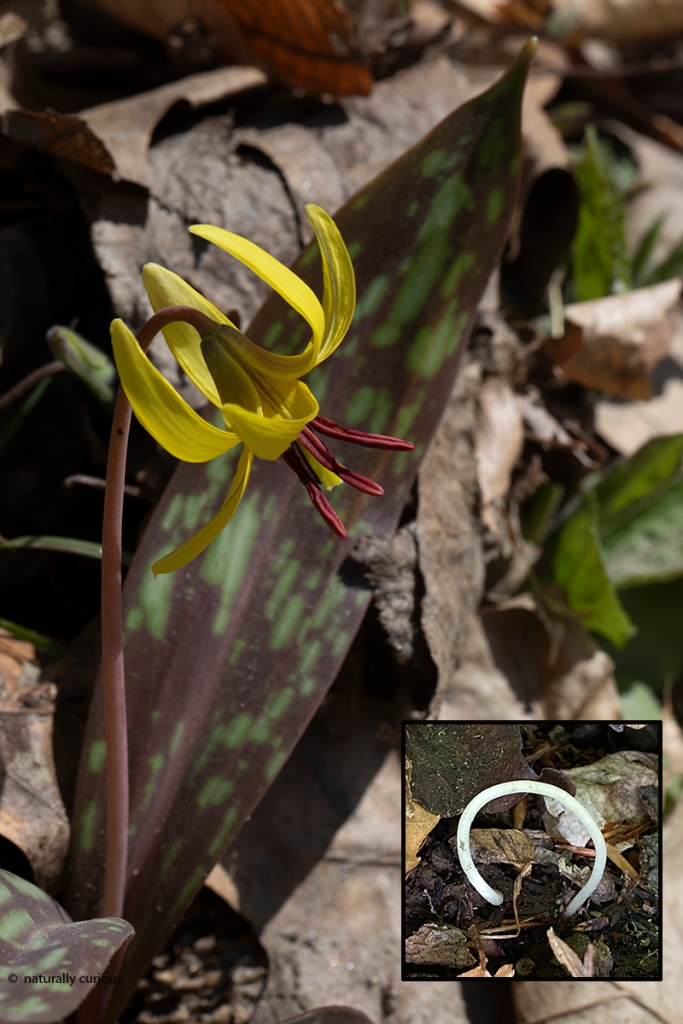The Bizarre Bill Of The Common Gallinule

It’s quite likely you’ll hear a Common Gallinule before you see one (they make a variety of loud, harsh squawks and whinnies), but once you see one you’ll not forget the bright reddish/orange shield over its bill. This bird looks like a duck when it’s swimming, but should you chance to see it walking on floating vegetation such as lily pads, you’ll know why it’s classified as a rail as soon as you view its strong legs and long toes.
The orange “frontal shield” is a duller color and relatively small and flat during the winter. However, during the breeding season it becomes enlarged to almost twice its winter size and is used to attract a mate, threaten competitors, protect the bird’s face from dense vegetation and to defend territory. In native Hawaiian mythology, a Common Gallinule brought fire to humankind, in the process of which its forehead was scorched red.
Naturally Curious is supported by donations. If you choose to contribute, you may go to http://www.naturallycuriouswithmaryholland.wordpress.com and click on the yellow “donate” button.
Small & Large Cranberries Flowering

There are two dominant species of wild cranberries, Large (Vaccinium macrocarpon) and Small (Vaccinium oxycoccos), that can be found in acidic northern bogs. Large Cranberry has been cultivated in the U.S. and is the source of the store-bought juice, sauce and berries that we drink and eat. (In Europe and Russia, Small Cranberry is cultivated.)
Pictured is Small Cranberry. As you can see, the structure of the flower, with recurved petals and single style (longer, female part) and stamens (shorter male parts) exposed and pointed forward, bears a resemblance to the neck, head, and bill of a crane (hence, the name cranberry).
Related to blueberries and huckleberries, cranberries are high in nutrients and antioxidants. They are associated with the treatment of ailments including urinary tract infections, high blood pressure and certain kinds of cancer.
Naturally Curious is supported by donations. If you choose to contribute, you may go to http://www.naturallycuriouswithmaryholland.wordpress.com and click on the yellow “donate” button.
Eastern Box Turtles Mating & Laying Eggs

Eastern Box Turtles can be found throughout most of the Northeast (though not yet confirmed in Vermont). These turtles are well-known (and named) for their hinged bottom shell (plastron) which allows them to seal themselves in and be all but impenetrable to predators. Eastern Box Turtles, along with many other species of turtles, are currently engaged in courtship, mating and laying eggs. After climbing on top of the female and grasping her between the top (carapace) and bottom shell (which she spreads apart if sufficiently receptive) with his hind feet, the male leans back, plants his carapace on the ground and stands upright for up to an hour while they mate.
This one encounter provides the female with enough sperm to produce fertile eggs for up to four years. If the 4-8 eggs a female Eastern Box Turtle lays survive predation (skunks, raccoons foxes, crows), they will hatch in August or September. As in other turtle species, the temperature of the nest determines the sex of the hatchlings. Warmer nests tend to produce females, while cooler nests produce males.
Naturally Curious is supported by donations. If you choose to contribute, you may go to http://www.naturallycuriouswithmaryholland.wordpress.com and click on the yellow “donate” button.
Buckbean Flowering

If you are within driving distance of a bog, June is prime time to visit. Pitcher plants, orchids and many other acidic-loving plants are in flower at this time of year. One of my very favorites is Buckbean (Menyanthes trifoliata).
Buckbean’s elaborately fringed petals are unique. The most plausible explanation for this seems to be that the intertwined, twisted fringes prevent small insects, which are not functional pollinators, from reaching the flower’s nectar. Larger bumble bees, flies and butterflies, which, for the most part, manage to avoid becoming entangled in these fringes, do reach the nectar and are effective pollinators.
Naturally Curious is supported by donations. If you choose to contribute, you may go to http://www.naturallycuriouswithmaryholland.wordpress.com and click on the yellow “donate” button.
Trout-Lily Stolon

Now that trees have leafed out, shaded spring ephemerals have flowered and disappeared, their bright blossoms mere memories. However, signs of their presence still remain, including Trout Lily’s efforts to reproduce vegetatively. Congratulations to Sara Hand who was the first NC reader to correctly identify Friday’s Mystery Photo’s subject — a “dropper” or stolon (tubular, fleshy stem) growing from the underground bulb of a young Trout-Lily plant, which most likely bore one leaf and no flower. The tip of the stolon eventually grows back into the soil, where it produces a new bulblet. The stem connecting the two bulbs then dies. Each new bulblet repeats the process in subsequent years resulting in colonies of clonal sister plants which are genetically identical. (Spring Wildflowers of the Northeast, by Carol Gracie)
Naturally Curious is supported by donations. If you choose to contribute, you may go to http://www.naturallycuriouswithmaryholland.wordpress.com and click on the yellow “donate” button.



















What Other Naturally Curious People Are Saying